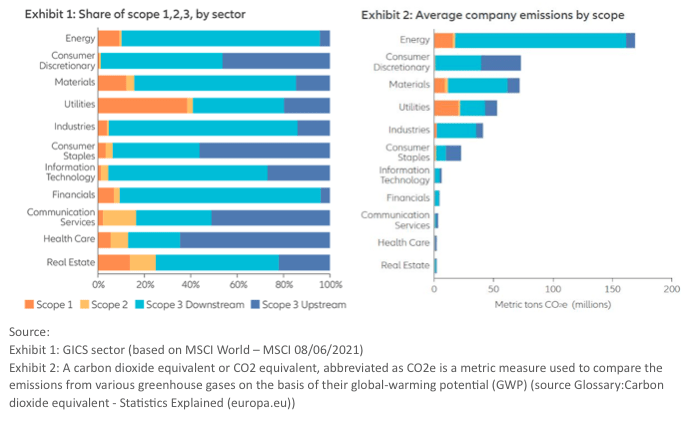By Allianz Global Investors – Sustainability Team
The race is on for companies to declare their commitment to achieving net-zero emissions, as outlined in the Paris Agreement. But given the various inconsistencies in how the phrase is understood, what does “net zero” really mean – and how should progress towards this goal be measured?
Key takeaways
1. Net zero, where there is no net accumulation of greenhouse gases in the atmosphere, will require companies to account for emissions generated by all business activities;
2. Investors can influence the climate transition pathway by investing in companies that commit to net zero through compelling plans and a proven ability to execute on them;
3. Engagement with investee companies is key to understanding sometimes complex decarbonisation strategies, reinforcing transparency, and promoting real progress to net zero;
4. Allianz Global Investors is adopting an innovative engagement approach with its investee companies to help tackle the climate emergency.
Once a piece of jargon used by climate experts, the term “net zero” has swiftly entered the mainstream in the run-up to the UN Climate Change Conference (COP26) in November 2021. Many countries, regions, companies and investors are announcing climate action goals and targeting net zero by a specific date, usually around the middle of this century – per the goals set out in the Paris Agreement on climate change.
Participation in the Race to Zero – an initiative of the UN Framework Convention on Climate Change to rally the largest-ever alliance committed to net-zero carbon emissions – has grown to 4,800 entities since the campaign’s launch in June 2020. Corporate entities account for around 3,000 of this number. This makes it easier for investors to identify those companies that are working towards this goal.
Considering the most recent Intergovernmental Panel on Climate Change (IPCC) report, described as a “code red for humanity”, this acceleration in global mobilisation towards the Paris Agreement objective is an encouraging development. But as investors look to allocate money towards companies contributing to climate transition, it is useful to examine the meaning of the phrase “net zero” and ask whether all net-zero goals are equal.
What is net zero?
The term “net zero” derives from a 2013 IPCC report, which discussed the need to eliminate net greenhouse gas (GHG) emissions to stop global warming. The “net” relates to the balance between emissions generated by human activities and those removed either naturally or artificially through carbon-capture technologies. The report paved the way for the Paris Agreement in 2015, with each signatory pledging to meet the targeted equilibrium – “net zero” – by 2050 at the latest.
The idea of equilibrium sounds like a simple equation. But for investors who want to support this target through the companies they invest in, the parameters around the underlying calculation are more complex, revealing competing definitions around what is meant by net zero.
For instance, a net-zero target is strictly achieved only when the full range of an entity’s activities are included. Yet some companies in some industries (for example, utilities) currently calculate their net-zero activities without including certain geographic regions; in other sectors (such as mining) some companies discount specific assets; while in other sectors (such as telecoms and media) some firms do not include all business structures. However, a best-practice approach should include all business activities across every division of a company, even if timelines may differ between them.
Ensuring that Scope 3 emissions are calculated
In the world of net-zero reporting, there are three classifications of emissions:
- Scope 1: direct emissions from sources that a company owns or controls, for example, emissions from a car manufacturer’s own factory.
- Scope 2: indirect emissions from the generation of energy purchased by the reporting company, for example, emissions relating to the energy used by that car manufacturer.
- Scope 3: indirect emissions produced outside the company’s direct control through its entire value chain – these include emissions from before goods enter the company’s gates (“upstream”), for example emissions resulting from the production of steel needed to build the cars, and emissions resulting from handling, distribution and usage of the final product (“downstream”), for example those resulting from the car’s own fuel consumption.
Scope 3 accounts for a substantial share of total emissions in many sectors, but for many firms it is only partially included in calculations for their net zero targets, if at all. We think this is potentially confusing and frustrating for investors who want to know what types of emissions are being included in net-zero targets, and whether there is clear disclosure around those targets.
At Allianz Global Investors, we actively encourage companies to develop and implement policies and practices to target a fully scoped net-zero commitment. Our recent analysis of a mining company indicated that, while it had committed to net-zero targets for Scope 1 and Scope 2 emissions, it was also able to quantify and disclose a full inventory of Scope 3 emissions, broken down into 15 categories over its entire value chain. The company has now put in place initiatives to reduce full-scope emissions for those Scope 3 categories over which it has some control, such as shipping.
Some sectors currently feel limited pressure to focus on their net-zero activities because they have low Scope 1 and 2 footprints. We expect the focus on monitoring Scope 3 to increase, to ensure equivalence across sectors, and greater alignment with the wider climate effort.
Greenhouse gas (GHG) emissions by sector
Carbon offsets: what role do they play on the journey to net zero?
“Carbon offsets” is a catch-all description for all the tools that companies or institutions can use to reduce GHG contributions in one area to compensate for emissions made elsewhere. They are a divisive factor in the net-zero equation. While there is strong consensus about the critical role offsets can play in corporate net-zero strategies, there is still debate around how much they actually contribute. We identify two conditions that should be attached to their use:
- Carbon offsets should not compromise gross emission reduction actions.
- Activities underpinning the claimed offsets should effectively, sustainably and verifiably reduce carbon emissions without undermining other sustainability aspects (such as biodiversity and social priorities).
Carbon offsets add an additional layer of complexity as we engage with companies to assess their progress towards net zero. We need to consider each company’s offsetting activities in their entirety, in the context of the relevant offsetting strategies that are available. Businesses can choose to compensate gross emissions through indirect investment into carbon credits, or through direct investment into lowering emissions or reducing activities – both within and outside their value chain. Options for the latter include carbon capture, utilisation and storage (CCUS).
On a broader level, our view of companies’ climate reporting suggests the use of carbon offsets is not yet meaningful at an aggregated level. However, they are being used increasingly in some sectors, such as financials. They are also the only solution against residual emissions that cannot be eliminated, which are estimated to account for around 20% of current emissions.
Consistency is key
As the flagship goal of the Paris Agreement, net zero is a powerful concept – but the reality of achieving it is complex. A robust framework to measure and scope out investee companies’ climate factors, supported by a rigorous, ongoing engagement process, is critical in directing capital towards achieving shared climate goals.
We hope the unprecedented surge in pledges to achieve net zero will continue. They should be complemented by greater consistency and agreement on how we collectively define net zero, which should in turn help further drive mobilisation on a global scale.
Please visit the website of Allianz Global Investors to read more
Investing involves risk. The value of an investent and the income from it may fall as well as rise and investors might not get back the full amount invested. Past performance is not a reliable indicator of future results. This is a marketing communication issued by Allianz Global Investors GmbH, www.allianzgi.com, an investment company with limited liability, incorporated in Germany, with its registered office at Bockenheimer Landstrasse 42-44, 60323 Frankfurt/M, registered with the local court Frankfurt/M under HRB 9340, authorised by Bundesanstalt für Finanzdienstleistungsaufsicht (www.bafin.de). Contact details and information on the local regulation are available here (www.allianzgi.com/Info). Further information on Investor Rights are available here (www.regulatory.allianzgi.com)




